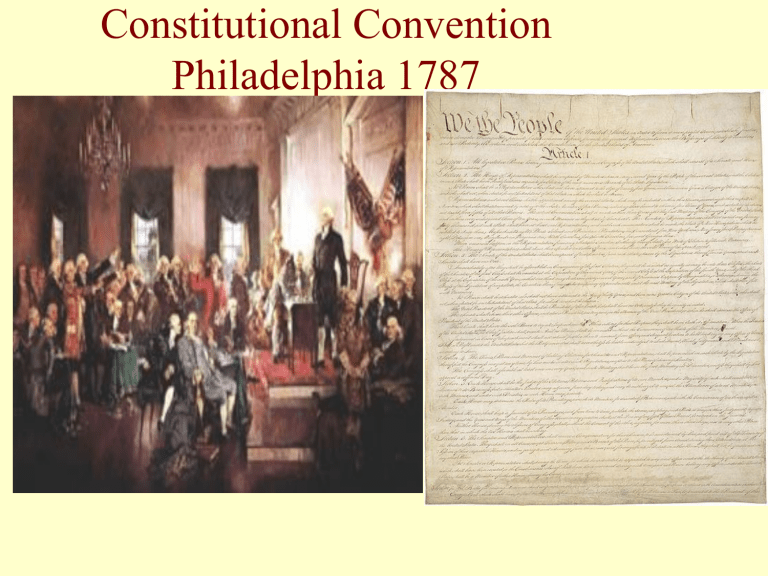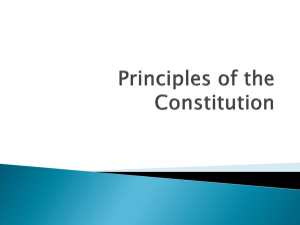Chapter 3 The Founding and the Constitution

Constitutional Convention
Philadelphia 1787
THE CONSTITUTIONAL TRADITION
IMPORTANT ANTECEDENTS
•
MAGNA CARTA, 1215
– FEDUAL RIGHTS AND LIMITING POWER
•
MAYFLOWER COMPACT, 1620
– CONTRACTUAL GOVERNMENT
•
COLONIAL CHARTERS, 1630-1732
– CHARTERS AUTHORIZING THE COLONIES
•
DECLARATION OF INDEPENDENCE, 1776
–
CREATING THE FRAMEWORK FOR A NEW
NATION AND ITS GOVERNMENT
•
ARTICLES OF CONFEDERATION, 1781-
1789
– AN ALLIANCE OF INDEPENDENT NATIONS
The Articles of Confederation:
• Inability to tax resulting in a weakening of bonds
• Trade wars erupted between the states
• Inflation resulted from each state printing currency
PROBLEMS
FOR A NEW NATION
•
FINANCIAL DIFFICULTIES
– NEED FOR TAXATION
•
COMMERCIAL OBSTACLES
–
TARIFFS BETWEEN STATES
•
CURRENCY PROBLEMS
–
STATES ISSUED THEIR OWN
MONEY
•
CIVIL DISORDER
– OPEN REBELLIONS AGAINST THE
NEW GOVERNMENT
Powers of the Congress Under the Articles of
Confederation
THERE WAS MORE AGREEMENT THAN CONFLICT IN
PHILIDELPHIA AT THE 1787 CONVENTION
•
LIBERTY AND PROPERTY
– INALIENABLE RIGHTS
•
SOCIAL CONTRACT
– CONSENT TO GOVERN AND THE
PROMISE OF SECURITY
•
REPRESENTATIVE GOVERNMENT
–
REPUBLICANISM
•
LIMITED GOVERNMENT
–
A SYSTEM OF CHECKS AND BALANCES
•
NATIONALISM
– AGREEMENT OVER HAVING A STRONG
NATIONAL GOVERNMENT
…AND THE CONFLICT
•
REPRESENTATION
– SERIOUS DISAGREEMENTS OVER HOW THE PEOPLE
WOULD BE REPRESENTED
•
THE VIRGINIA PLAN
•
THE NEW JERSEY PLAN
•
THE CONNECTICUT COMPROMISE
• SLAVERY
– THE DESIRE OF SOME STATES TO COUNT SLAVES TO
DETERMINE REPRESENTATION
• VOTER QUALIFICATION
– PROPERTY QUALIFICATIONS
– SOME STATES RESTRICTED VOTING TO “FREE,
WHITE, MALE CITIZENS”
The Constitutional Convention:
Conflict and Compromise
• The Virginia Plan- proposed 3 branches of govt., bicameral house, it favored states with large populations
• The New Jersey Plan- proposed 3 branches of govt., unicameral house and favored the smaller states.
• The Great Compromise reached a compromise over representation- 3 branches of govt., bicameral house with equal representation in Senate and
House of Representatives based on state’s population.
The Constitutional Convention:
The Question of Slavery
• Were the slaves to be counted for representation purposes?
• The slave population would count as 3/5 of a person for taxation and representation purposes.
The Constitution
The Constitution embraces seven basic principles.
1) Republicanism-
2) Federalism
3) Separation of Powers
4) Checks and Balances
5) Popular Sovereignty
6) Limited Government
7) Individual Rights
3 Branches and Separation of
Powers
The Constitution: Three Branches
• Article I- creates and outline qualifications and duties of the Legislature Branch
• Article II- creates and outline qualifications and duties of the Executive Branch
• Article III- creates and outlines qualifications and duties of the Judicial
Branch
The Fight for Ratification
Federalists v. Anti-Federalists
• The Federalists and the Anti-
Federalists, each had viewpoints worth examining, as they both have sound reasoning.
• These two groups debated the necessity and design of the new and stronger central government on the following grounds
The Anti-Federalists did not want to ratify the
Constitution. Basically, they argue that:
• It gave too much power to the national government at the expense of the state governments.
• There was no bill of rights.
• The national government could maintain an army in peacetime.
• Congress, because of the `necessary and proper clause,' wielded too much power.
• The executive branch held too much power.
The Federalists had answers to all of the
Anti-Federalist complaints.
• The separation of powers into three independent branches protected the rights of the people. Each branch represents a different aspect of the people, and because all three branches are equal, no one group can assume control over another.
• A listing of rights can be a dangerous thing. If the national government were to protect specific listed rights, what would stop it from violating rights other than the listed ones? Since we can't list all the rights, the Federalists argued that it's better to list none at all.
The Bill of Rights
• The first 10 amendments of the Constitution
• #1 Religion, speech, and press
• #2 Right to bear arms?
• #3 Quartering troops
• #4 Security from unwarrantable search and seizure.
• #5 Rights of Accused Persons in Criminal Proceedings
• #6 Right to Speedy Trial, Witnesses, Etc.
• #7 Trial by jury
• #8 Limits of fines and punishments
• #9 Right of people
• #10 Powers Reserved to the States or People






